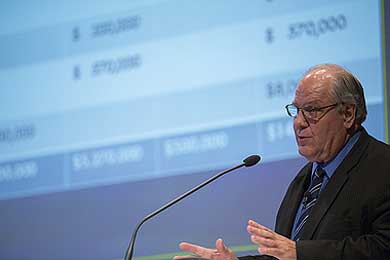
The Seventh-day Adventist Church received U.S. $2.33 billion in returned tithe worldwide last year, treasurer Robert E. Lemon told 2013 Annual Council delegates on October 14.
Tithe returned in the North American Division for 2012 was up about 1 percent from 2011 and totaled US$933 million. Tithe from divisions outside of North America increased 4.4 percent for a total of close to $1.4 billion. In the church’s South American Division alone, members returned nearly $530 million in tithe.
Mission offerings from outside North America similarly rose, reaching about $60 million, a 6 percent increase from the previous year. Meanwhile, mission offerings from North America dipped 2.6 percent, but still totaled nearly $23 million.
Commenting on the results, Lemon said the generosity of church members led by God’s spirit, not appropriations, will finish the work of the Seventh-day Adventist Church. And young lay people, more often than senior administrators, will ignite that work.
He acknowledged that his prediction might seem out of character—even “meddlesome”—in the context of a financial report to Annual Council delegates, but the Adventist world church treasurer is convinced that it’s time for a sea change in how the church is funded and directed.![BRING IN YOUTH: Adventist world church Treasurer Robert E. Lemon calls for more inclusion of young adults in more financial decision-making in the denomination during his report to Annual Council on October 14. [PHOTO: Brandan Roberts/ANN]](https://adventistreview.org/wp-content/uploads/2022/01/ac2013-9-1.jpg)
First, he wants to see more grassroots financial support for projects.
“Our church has a history of thinking that if a project is worthwhile, it must have millions and millions of dollars of funding behind it, but the work isn’t going to be finished by the money in the [church]’s bank account,” Lemon said.
One case in point is the Great Controversy Project, he said. The book distribution project received less funding from the General Conference budget than Adventist world church headquarters spent on travel expenses for delegates to attend Annual Council. But members worldwide who supported the project shared more than 140 million copies of the book, which was authored by church co-founder Ellen G. White.
Going forward, Lemon said he and other church financial leaders would like to see more projects that empower lay people to take similar initiative.
“When God’s children get excited about something, they take money out of their pockets,” Lemon said.
Meanwhile, church financial leaders will continue to concentrate funding in areas with little or no Adventist presence. In Pakistan, $300,000 will fund a shelter for at-risk girls. In Myanmar, $400,000 will pay to reopen the Yangon Adventist International School. Another $500,000 will go toward building a center of influence and a vegetarian restaurant in Brunei, where an Adventist presence is not yet established.
Delegates also approved a proposal to send $570,000 to the MORE Project, which publishes books and pamphlets contextualized for other religious audiences. Another $4 million will step up production at the media center in the church’s Middle East North Africa Union. Currently, the media center produces programming in Arabic, but local leaders are eager to expand to other languages.
It was no coincidence, then, when he asked delegates to approve a proposal to use the mission offering collected at the 2015 General Conference Session to fund outreach and evangelism projects overseen by Adventist young people ages 25 and under. Projects would receive approval from a new committee on which 75 percent of the members will be young adults.
“It’s time that we tell our young people that we not only trust them to do the work, but we also trust them to make decisions as to how to spend the money of the church,” Lemon said.
“It’s interesting how our perception of youth has changed,” Lemon said, noting that a study of early church history reveals that most of the church’s founders were teenagers or 20-somethings. “Young people” when the church was established 150 years ago were not the late 30- and 40-somethings who are labeled “young” administrators today, Lemon said.
He urged delegates to take advantage of upcoming opportunities to “leave young people a seat at the table of decision-making.” In early 2014, each of the church’s 13 divisions will select delegates to the 2015 General Conference Session.
“We have the young people. We have the women, who constitute a majority of our church. We have the funds, although most of it is still in our own pockets. And we have the blessings of the Lord. This work is going to be finished. The question is, are we going to be a part of it? Or are we just going to have to move out of the way?” Lemon asked delegates.
“We are one church, one family, and we have a work to finish,” he said.